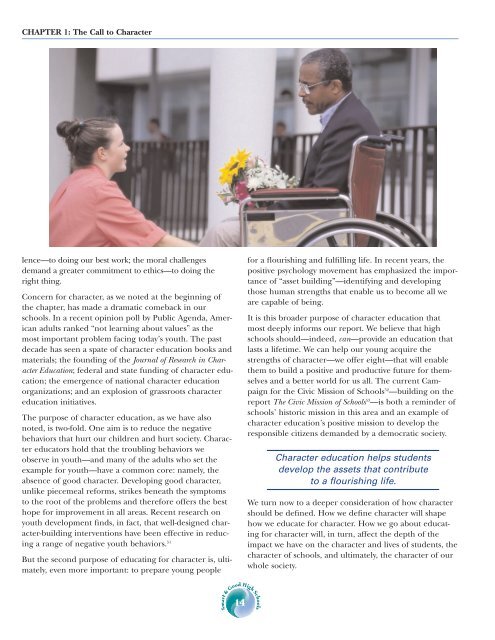CHAPTER 1: <strong>The</strong> Call to Characterlence—to doing our best work; the moral challengesdemand a greater commitment to ethics—to doing theright thing.Concern for character, as we noted at the beginning ofthe chapter, has made a dramatic comeback in ourschools. In a recent opinion poll by Public Agenda, Americanadults ranked “not learning about values” as themost important problem facing today’s youth. <strong>The</strong> pastdecade has seen a spate of character education books andmaterials; the founding of the Journal of Research in CharacterEducation; federal and state funding of character education;the emergence of national character educationorganizations; and an explosion of grassroots charactereducation initiatives.<strong>The</strong> purpose of character education, as we have alsonoted, is two-fold. One aim is to reduce the negativebehaviors that hurt our children and hurt society. Charactereducators hold that the troubling behaviors weobserve in youth—and many of the adults who set theexample for youth—have a common core: namely, theabsence of good character. Developing good character,unlike piecemeal reforms, strikes beneath the symptomsto the root of the problems and therefore offers the besthope for improvement in all areas. Recent research onyouth development finds, in fact, that well-designed character-buildinginterventions have been effective in reducinga range of negative youth behaviors. 51But the second purpose of educating for character is, ultimately,even more important: to prepare young peoplefor a flourishing and fulfilling life. In recent years, thepositive psychology movement has emphasized the importanceof “asset building”—identifying and developingthose human strengths that enable us to become all weare capable of being.It is this broader purpose of character education thatmost deeply informs our report. We believe that highschools should—indeed, can—provide an education thatlasts a lifetime. We can help our young acquire thestrengths of character—we offer eight—that will enablethem to build a positive and productive future for themselvesand a better world for us all. <strong>The</strong> current Campaignfor the Civic Mission of <strong>Schools</strong> 52 —building on thereport <strong>The</strong> Civic Mission of <strong>Schools</strong> 53 —is both a reminder ofschools’ historic mission in this area and an example ofcharacter education’s positive mission to develop theresponsible citizens demanded by a democratic society.Character education helps studentsdevelop the assets that contributeto a flourishing life.We turn now to a deeper consideration of how charactershould be defined. How we define character will shapehow we educate for character. How we go about educatingfor character will, in turn, affect the depth of theimpact we have on the character and lives of students, thecharacter of schools, and ultimately, the character of ourwhole society.14<strong>Smart</strong> & <strong>Good</strong> <strong>High</strong> <strong>Schools</strong>
1C. Peterson & M. P. Seligman, Character strengths and virtues. (NewYork: Oxford University Press, 2004).2T. Lickona, Character matters: How to help our children develop goodjudgment, integrity, and other essential virtues. (New York: Touchstone,2004).3Breaking ranks II: Strategies for leading high school reform. (Reston, VA:National Association of Secondary School Principals, 2004).4Kaiser Family Foundation survey, http://www.kff.org (2002).5J. Rosenbaum, Beyond college for all: Career paths for the forgotten half.(New York: Russell Sage Foundation, 2001).6P. E. Barton, Parsing the achievement gap. (Princeton, NJ: EducationalTesting Service, 2003).7Barton.8P. Ewell, D. Jones, & P. Kelly, Conceptualizing and researching the educationalpipeline. (Boulder, CO: National Center for <strong>High</strong>er EducationManagement Systems, 2003).9R. Balfanz & N. Legters, Locating the dropout crisis. (Baltimore, MD:Center for Social Organization of <strong>Schools</strong>, 2004).10American Freshman, 2003. (UCLA annual survey)11American Freshman, 2004.12F.M. Hess, “Status quo vs. common sense,” Education Week (April14, 2004).13R. Kazis et al., “Shoring up the academic pipeline,” Education Week(March 24, 2004).14Based on the research of Kenneth Gray, cited in Adria Steinberg,Real learning, real work. (New York: Routledge, 1998).15American Freshman, 2003.16Center for Information and Research on Civic Learning andEngagement, <strong>The</strong> civic mission of schools (2003).17<strong>The</strong> civic mission of schools.18D. McCabe, Center for Academic Integrity, www.academicintegrity.org19D. McCabe, “Cheating: Why students do it and how we can helpthem stop,” American Educator (Winter 2001).20“Violence-related behaviors among high school students—UnitedStates, 1991-2003,” in CDC’s Morbidity and Mortality Weekly Report,http://www.cdc.gov/mmwr/preview/mmwrhtml/mm5329a1.htm (August8, 2004).21K A. Moore, “<strong>The</strong> state of America’s children 2003: <strong>The</strong> goodnews and the bad,” http://www.childtrends.org/files/CommunitarianTalk.pdf22Alfred University, Initiation rites in American high schools: Anational survey, http://www.alfred.edu/news/html/hazing_study.html (2000).23<strong>The</strong> sourcebook of criminal justice statistics 2001,www.albany.edu/sourcebook24Institute for American Values, Hardwired to connect,www.americanvalues.org/html/hardwired.html (2003).25Adolescent Health Chartbook, www.cdc.gov26www.monitoringthefuture.org/pubs/monographs/overview2003.pdfEndnotes27www.monitoringthefuture.org28Centers for Disease Control and Prevention, Youth Risk BehaviorSurvey (2001).29“Preventing teenage pregnancy, childbearing, and sexually transmitteddiseases: What the research shows,” Child Trends Research Brief(May 2002).30Centers for Disease Control, 2003.31National Center on Addiction and Substance Abuse at ColumbiaUniversity, 2004 CASA national survey of American attitudes on substanceabuse IX: Teen dating and sexual activity (2004).32Rosenbaum, 116.33Rosenbaum, 112.34Rosenbaum, 270.35Futures for Kids, www.f4k.org36F. Levy & R. Murnane, “Preparing students for work in a computer-filledeconomy,” Education Week (September 1, 2004).37McCabe.38D. Callahan, <strong>The</strong> cheating culture. (New York: Harcourt, 2004), 8-12.39Callahan, 17.40Callahan, 286.41Kids & media at the new millennium, a 1999 Kaiser Family Foundationreport, www.kff.org, found that 49% of parents “had norules about TV”; a Newsweek survey in the 1990s had put the figureat 60%.42D. Zuckerman, “What is to blame for youth violence?”,www.center4policy.org/violencej.html (March 2001).43Harris Interactive and Teenage Research Unlimited, Born to bewired: Understanding the first wired generation, http://us.yimg.com/i/promo/btbw_2003/btbw_execsum.pdf (July 2003).44Science (March 2002).CHAPTER 1: <strong>The</strong> Call to Character45For one review of this literature, see Daniel Linz et al., “Effects oflong-term exposure to violent and sexually degrading depictions ofwomen,” Journal of Personality and Social Psychology, 1988, 55, 5, 758-768.46K. S. Hymowitz, “Parenting: <strong>The</strong> lost art,” American Educator(Spring 2001).47Hymowitz, 8.48P. Tyre et al., “<strong>The</strong> power of no,” Newsweek (September 13, 2004),44.49R. Putnam, Bowling alone: <strong>The</strong> collapse and revival of American community.(New York: Simon & Schuster, 2000).50T. Gitlin, Media unlimited: How the torrent of images and sounds overwhelmsour lives. (New York: Owl Books, 2003).51See, for example, the articles by V. Battistich and J. Benninga inthe fall, 2003 issue of the Journal of Research in Character Education(www.infoagepub.com).52http://www.civicmissionofschools.org/53http://civicmissionofschools.org/campaign/documents/CivicMissionof<strong>Schools</strong>.pdf15<strong>Smart</strong> & <strong>Good</strong> <strong>High</strong> <strong>Schools</strong>















